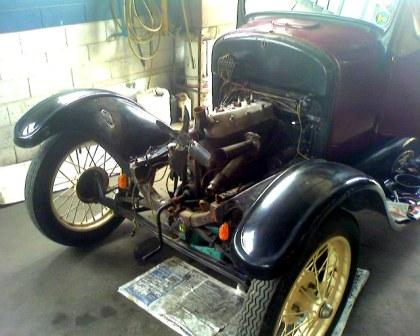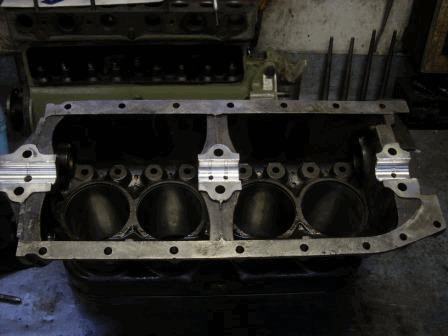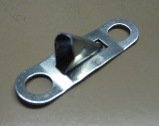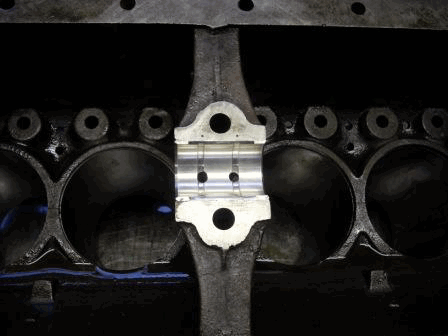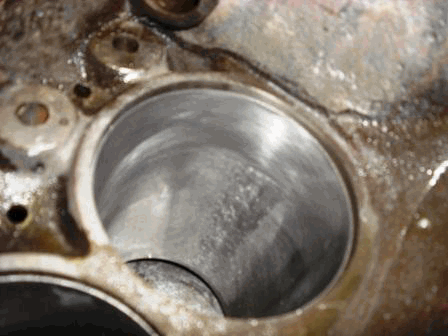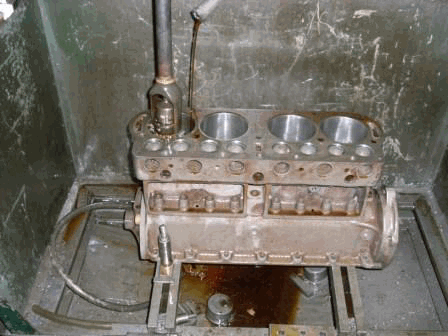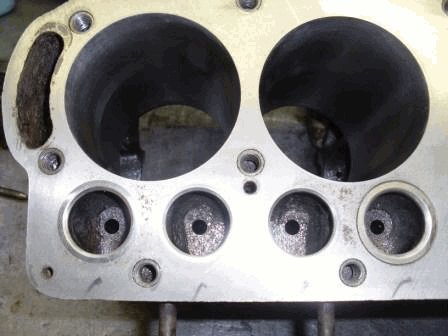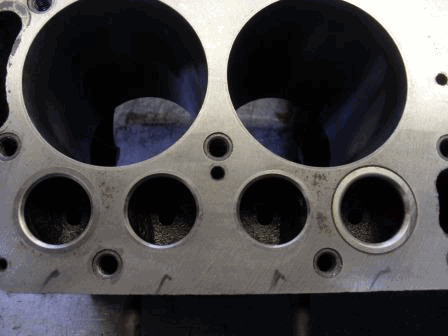|
The Model T Ford Engine
The Model T Ford engine is a 4 cylinder, sidevalve unit operating on the 4 stroke cycle and featuring an integrated transmission and magneto
Although continuous changes were made throughout the life of the Model T Ford engine, it basically remained the same. The cylinders and crankcase were cast in one with three main bearings for the crankshaftand a fourth at the rear of the transmission assembly. The crankshaft and conrod bearings are white metal or babbit bearing poured into the block or rod and then scraped to fit. Bearings and Lubrication
A model of simplicity, the lubrication system for the Model T was the then popular splash method. The engine pan early on had three impressions, one under each conrod, with a fourth being added in later years. Once filled with oil, the rotation of the crank splashed oil pooled in these impressions, the excess flowing backwards to the sump. The flywheel, fitted with paddles, also added to the effect as it rotated. To improve oil supply to the front bearings, an internal oil pipe is fitted with a collector, directing oil from behind the flywheel/magneto as it drips down from the top of the trasmission case and gravity feeds along the pipe, exiting near the front main bearing. Unfortunately, the main flaw with this system occurred when climbing steep hills. The effect of the gradient and gravity, drastically reduced the oil flowing to the front of the engine. In addition, loose fibres released from the cotton transmission bands eventually clogged the oil line if it wasn't cleaned. Now 80yrs+ on, most Model T owners fit accessory oil pan dippers.
Pistons and Heads The Model T engine, as was common at the time, was fitted with cast iron pistons. The Model T's were of 3 3/4" diameter and combined with a stroke of 4" created a displacement of 2.89 litres or 176.7 ci, developing 20hp. In the very early years, the engine developed 22hp on a compression ratio of 4.5:1 which was subsequently reduced to 4:1 in 1912 and then again to 3.98:1 for the remainder of the production period. It is now common practice, when Model T engines are reconditioned, to fit a modern aluminium equivalent. Although a little noisier in operation, they weigh considerably less and this reduced reciprocating mass takes a fair bit of stress and wear off the crankshaft and bearings. If you're considering reconditioning a Model T Ford engine, bare in mind that the Model T was originally designed with much lower engine speeds in mind. A number of design calculations were made with the engine operating at around 1500 rpm (generator charging speeds in later cars for example)and both options have their pro's and con's. I would recommend that you seek as much advice from professional engine reconditioners and experienced enthusiasts as possible before making a decision. As you would expect with an engine that in most cases is at a minimum, 80 years old, wear takes it toll. Oversized pistons are available from a number of spare parts suppliers up to 0.060". Where an engine has been previously rebored to the extent that the engine reconditioner can not bore it out any more, a common practice is to fit cylinder liners in thicknesses that can bring the bore dimensions back to standard size. The image below shows an engine that has had this done (view from the underside) The original bore is machined to the exernal dimensions of the new sleeve and with a combination of press fit and modern "gripping agents" the liner is inserted. Note in the image that the liner does not come all the way to the bottom of the bore. A lip is left during machining that the liner sits on in the bottom of the bore, stopping it from moving down.
With the main machining of the bores complete, the liners are "honed" before the pistons can be inserted with the rings into the bores (this is done wih the con rods attached, ready to be bolted to the crank) The image below shows an engine block being honed
Attention now moves to the valves. In the Model T Ford, the valves are located in the engine block adjacent to the cylinders, rather than in the head as is the case in modern engines. Following the removal of the lead compounds in fuel in the 1980's, a condition known as valve seat recession or VSR was exacerbated, the lead helping to reduce this action. Valves are exposed to extreme conditions, particularly the exhaust valves which reach temperatures in the hundreds of degrees. A common alteration made to older engines is the fitting of hardened valve seats which reduce the amount of wear. Once the seats have been fitted, they are machined flat with the surface of the rest of the block
In the image that follows, you can see where the new hardened seats have been fitted into the block surface. The valve seat on the left has had its facing cut to provide the correct face angle. The valve seat on the far right, has also had a face cut and you can clearly see the recession of the old valve seat where it has worn into the block surface (the dark ring around the new seat)
So what sits on top? The Model T Ford engine has always featured a cast iron head which in conjunction with the pistons produced a compression ratio of 4.5:1, well suited to the quality of the fuel of the day, with some owners even running the engine on gasoline/kerosene mixes.
Needless to say, the Model T Ford inspired a huge number of accessories and modified engine heads were among them. These varied from increased compression heads, those with better chamber design and overhead valve conversions to name some and brands such as Rajo were common amongst those who wanted more from their T. A common modern replacement is the aluminium "Z" head, a copy of a period head, now being reproduced as a very popular accessory. The "Z" head increases the Model T engine compression to 6:1 adding adding extra "oomph" for hill climbing, not bad for a bolt on and driveaway accessory which truly does transform the performance of the T from the standard 20hp to approximately 27HP! Having fitted one to my '27 Shooting Brake, the hill climbing ability is greatly improved.
Disaster strikesIt's taken me just over a year to get things organised, but in March 2009, 200 yards into a club run, my Model T came to an embarrassing halt on the side of the road. The diagnosis, a broken crankshaft. Not uncommon, but it seems my T had succumbed to the stresses of driving in modern traffic.
Return to Model T Ford Technical Page
|
